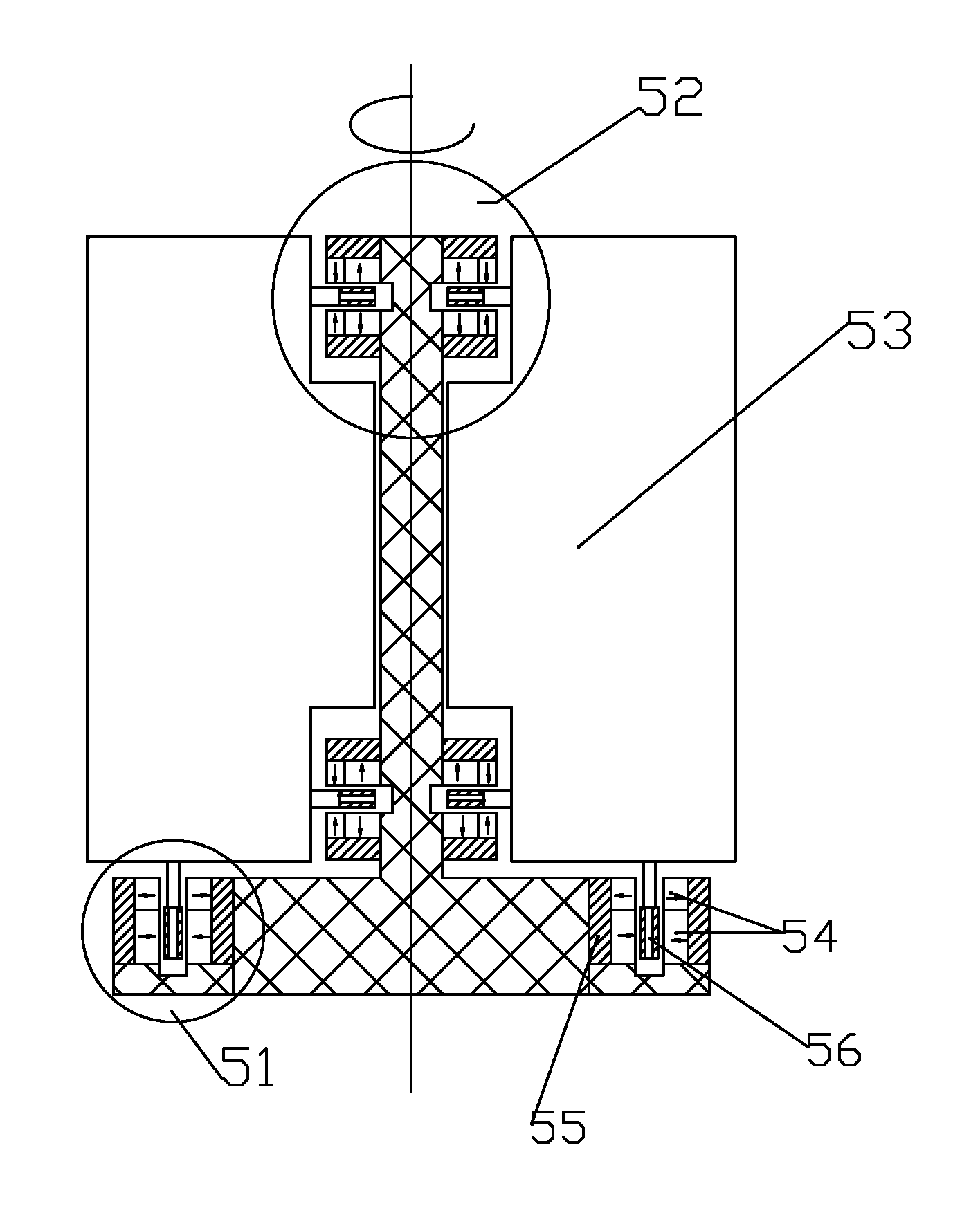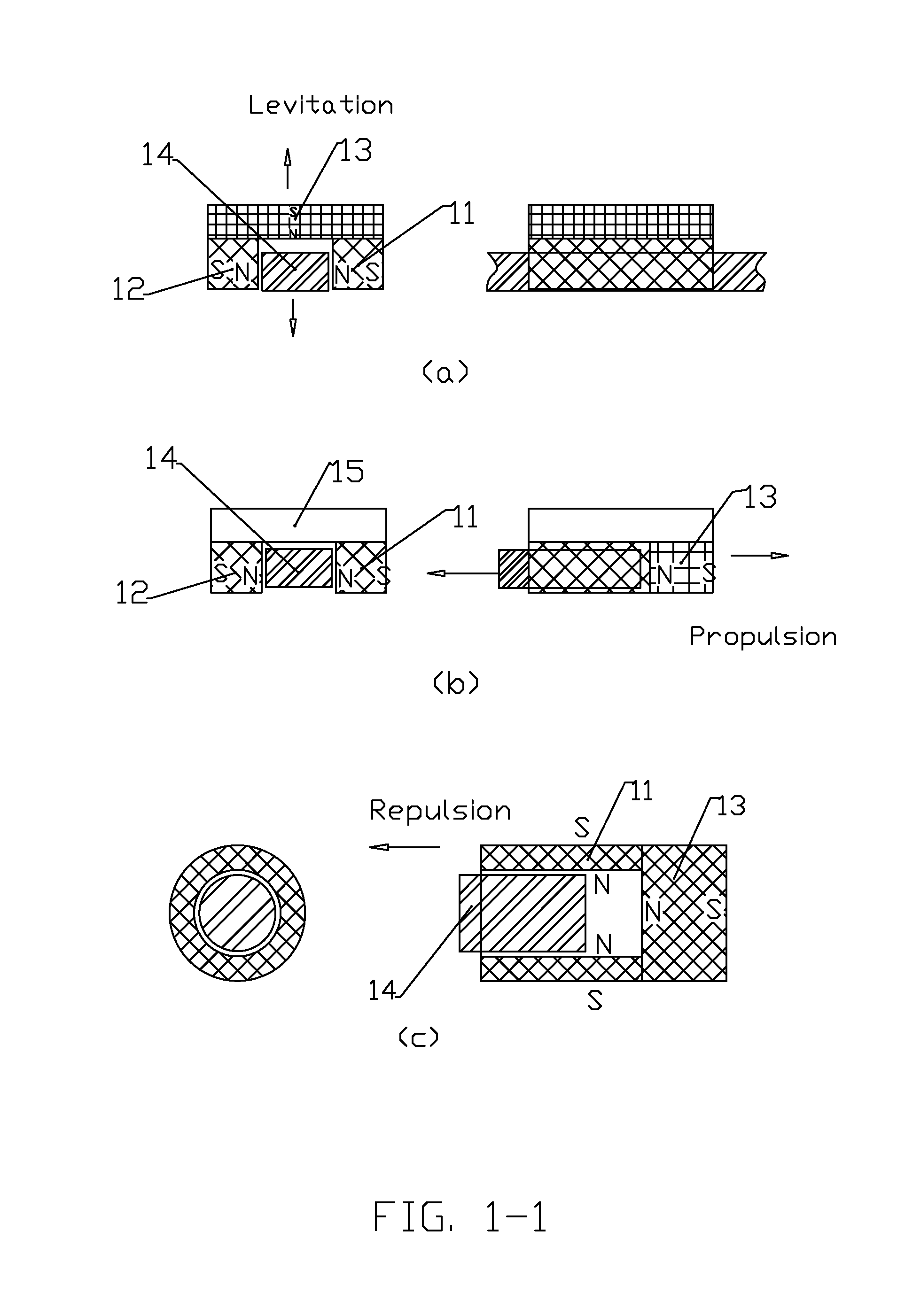Magnetostatic levitation and propulsion systems for moving objects
a technology of moving objects and propulsion systems, which is applied in the direction of machines/engines, electric generator control, transportation and packaging, etc., can solve the problems of high cost, high cost, and insufficient magnetic flux to support the weight of the train, so as to eliminate complexity, reduce cost, and reduce the effect of vibration
- Summary
- Abstract
- Description
- Claims
- Application Information
AI Technical Summary
Benefits of technology
Problems solved by technology
Method used
Image
Examples
second embodiment
[0032]FIG. 3 shows schematic description of a MSP long stator linear motor (LSLM) as the present invention. Assembly (a) in FIG. 3 is a schematic cross section and side view of the MSP LSLM that consists of a rotor assembly 48 and a long stator or steel rail assembly 44. The rotor assembly 48 is basically the similar one as illustrated in FIG. 1-2(b) and FIG. 2-2(b) that consists of two pairs of magnets 41 and 42. The magnets are electromagnets or a mixture of permanent magnets and electromagnets. The long stator or steel rail is made of alternating magnetic block 46 and nonmagnetic block 47 on a spacing pattern for the reasons above discussed. The electromagnets can be switched on or off by flowing a current with a waveform like 49 in FIG. 3(b) to match alternative positioning of the magnetic block 46 in between to pick up one direction propulsion force desired. By changing this matching the rotor or vehicle's acceleration or deceleration or applying brake can be functioned. The po...
third embodiment
[0033]FIG. 4 shows a schematic cross-section and side views of a MSS permanent magnet magnetic bearing (PMMB) system as the present invention. The whole structure is round along a shaft axis. The system consists of two sets of the MSS assemblies 61 and 62 with each set located at each end of a nonmagnetic shaft axis 63. The assembly 61 is to provide the shaft assembly 63 a horizontal spring-like balance force and the assembly 62 is to provide the shaft assembly 63 a spring-like vertical suspension. The assemblies are made of a bearing chock 64 or 65 and a steel ring assembly 66 or 67. Inside the bearing chocks there are two pairs of magnet rings aligned as illustrated to produce a spring-like force on the steel rings 66 and 67. The existence of the unstable rightward or leftward forces discussed above makes it a challenging in designing a MSS PMMB product, but a carefully design can still lead to a fully standstill suspension of the shaft assembly 63 and makes it spin around its axi...
fourth embodiment
[0034]FIG. 5 shows a schematic cross section of a MSS maglev wind turbine as the present invention. The turbine consists of a MSS assembly 51 and two MSS assembly 52. Weight of the turbine 53 is levitated up through the assembly 51 and its rightward or leftward forces are offset through the assembly 52. The assemblies consist of magnets 54, a flux return steel path 55 and steel ring assembly 56. All magnets are operatively attached to a base or foundation of the wind turbine rather than to the turbine body that has great meaning to lightweight the turbine load or inertia. A number of such assemblies might be used to meet a desired weight lifting power. In this design the turbine body can freely move vertically without a gap limitation that makes big sense in allowing a bigger weight variation or moving vibration during operation or loose manufacturing tolerances.
PUM
 Login to View More
Login to View More Abstract
Description
Claims
Application Information
 Login to View More
Login to View More - R&D
- Intellectual Property
- Life Sciences
- Materials
- Tech Scout
- Unparalleled Data Quality
- Higher Quality Content
- 60% Fewer Hallucinations
Browse by: Latest US Patents, China's latest patents, Technical Efficacy Thesaurus, Application Domain, Technology Topic, Popular Technical Reports.
© 2025 PatSnap. All rights reserved.Legal|Privacy policy|Modern Slavery Act Transparency Statement|Sitemap|About US| Contact US: help@patsnap.com



